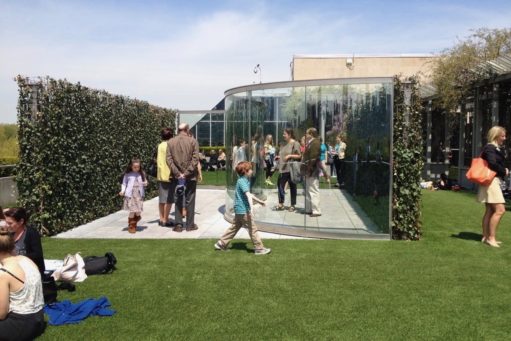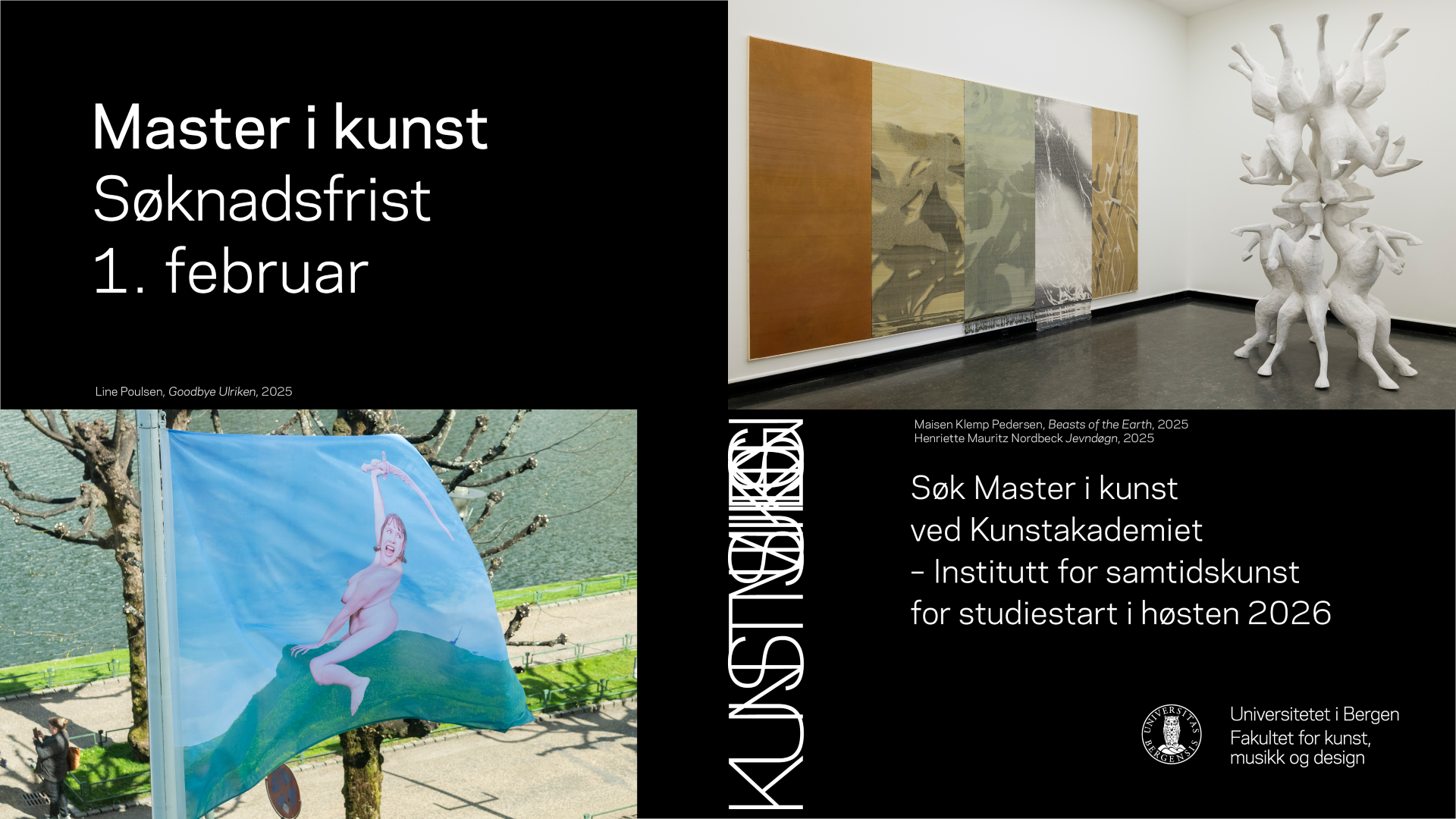
The north-west of Copenhagen is rather short on New York glamour on a grey, cold January day. However, there’s plenty to be found indoor at gallery Nicolai Wallner, which moved to new premises here last year, taking up residence in a converted garage. In the backroom of the gallery, 75-year-old Dan Graham sits in a wheelchair, entertaining the gallery staff in his broad New York dialect. He is obviously tired after the long journey from downtown New York, where he lives in central SoHo, but he’s also in a very good mood. According to his assistant, who is also present, Graham loves interviews because he gets to say exactly what he wants. He also hates when his works are misunderstood by critics.
Graham is in Copenhagen on occasion of tonight’s opening of his solo show Dan’s World at Nicolai Wallner. Here audiences can see three of the iconic pavilions (one from 2017, two from 2015) that Graham has produced since the late 1970s, and which can be found in sculpture gardens and public squares across the world. These architectural sculptures all adhere to the same formal, minimalist basic model where steel frames and glass are used to create unique variations on the theme.
Ever since Graham had his breakthrough in 1967 with the photo series Homes for America, which may still be his best-known work of art, the main starting point of his practice has been the city as an architectural and social phenomenon – whether it’s about the glossy facades of capitalism or socialist ideas about institutional spaces. He has worked with performance, installation and video art, and for a number of years he ran the John Daniels Gallery, where he exhibited artists such as Sol LeWitt, Donald Judd, Dan Flavin and Robert Smithson.

Therefore, it is hardly surprising that Graham peppers our conservation with the first names of some of the most prominent figures of art history. Indeed, the conversation became quite esoteric in parts. At the same time we clicked almost immediately because we both have Aries as our sign – even though Graham jokes a lot throughout the interview, he also takes many things very seriously, such as astrology. He seemed to know the star signs of everyone present in the gallery.
Displaying an impressive erudition within the field of art, he speaks willingly about his lifelong practice – including about how he essentially doesn’t believe in public art, but loves museums; particularly in the wake of Andrea Fraser’s institutional critique.
Your earliest works, printed in magazines in the mid-‘60s, predated a generation of artists finding the white cube restrictive. How has your own relationship with white walls and gallery spaces changed up until today?
I did not make these works as a challenge to the white cube or something like that. I loved printed matter – everyone did at that time. And since I wasn’t an artist yet and had very little money, putting things in magazines was a way of making art cheaply and with a certain sense of humour. Through the work of Sol LeWitt, I then got interested in the city plan and more specifically surburbia. That’s how Homes for America came upon. People still think it is a sociological critique of the suburbs. It was not. I had an interest in anthropology and read Margaret Mead – at first because of the photographs of naked women, I guess. But she had a huge influence on American culture during that time period. So the work is definitely more anthropological than sociological.
You did not think of these early works as institutional critique?
Never. I can’t take Andrea Fraser seriously. It’s incredibly dumb what she’s saying. Her interpretation of Michael Asher is totally false. And in terms of museums, I love museums. I think every decade the museums change. In the ‘80s for instance, the summer shows had to do with basically placing the art in gardens surrounding historical palaces, like Münster or Documenta. It was an interesting mixture of education and entertainment with families getting involved and going about looking at art on Sundays. I have no background in art, I never studied art. But more and more as I travel, I enjoy going to see art museums. So I don’t really understand this idea of institutional critique. It doesn’t make any sense to me.

The installation Public Space / Two Audiences, which was originally produced for the Venice Biennale in 1976, anticipated the ongoing series of pavilions you developed shortly after. Could you elaborate on how it began with a reflection on the pavilion structure so characteristic to this biennale?
The theme of the show was ambient art. So it was somewhat based on that and on the fact that at the Venice Biennale there is a pavilion dedicated to the most important art representing each particular country. I then decided to have the spectators in the place of the art. My inspiration for the piece came from various places, such as showcase windows, which fascinated me long before reading Walter Benjamin – maybe because I came to New York from New Jersey. Also, I was interested in telephone booths and bus stop shelters. I think the whole idea of people enclosed inside these booths or pavilion-like structures was about street architecture in a way.
So your interest in combining art and architecture grew from there?
I think it actually began with Sol LeWitt, whom I showed in my gallery. He was an architect and worked for I. M. Pei. And when I went to Los Angeles, Michael Asher and other artists there were talking about architecture. There was a strong influence of architecture in that period amongst L.A. and New York artists. Then in 1978, I came up with a bunch of models for a show at Museum of Modern Art in Oxford. Some of the pieces were a cross between sculpture and pavilions. Today, I’m a dedicated architecture tourist. Most architects have no time doing that. They just have stacks of Dan Graham books (laughs). Oh, and another thing. Artists have always thought of architects as fascists in a way. So I’m very happy that I’m some kind of hybrid!

Now your pavilions are all over the world. Do you consider each of them a site-specific piece?
Of course. Also, if I do an assignment for a private collector. For instance, one thing that is important is that it should be seen through the front living room because that’s where the guests will see it. It should not take space away from the children’s play area or from the barbeque area. Also, I think the client is always right in a way. I did a piece for a client who rejected my drawings and I am very happy she did so, because the piece that she wanted was a better piece. The interaction with the owners is extremely important. That’s why the piece is bought.
Talking private versus public investments in art, what’s your view on that?
A good example would be Tate Modern. I think it’s terrible and designed to get a lot of people in so it gets corporate funding. I have great love for the work of Tacita Dean, but I refused to actually go and see it there. What I like about her works is that they are quite small, because I don’t like spectacles. But this is the way its going now; everything is spectacle. My dream, my interest in a kind of European socialism is gone, even in Norway.
Coming back to the idea of street architecture, what’s your approach to art in public spaces?
I don’t know if I really actually believe in public art as such. I believe in the museum. After Fraser, I have come to love museums. The Met piece, for instance, was about the museum as tourist attraction with an observation deck like the Empire State Building.

So I guess we can skip my next question about what makes a well-functioning work of public art?
What I mean is that I think it has moments. I would rather say that it should continue to redefine existing institutions, like the museum. And another thing, I don’t think art should be static. I like the idea of moving through space, so a lot of my works involve walk-throughs. As a part of that, I think my works take place in time. I did a piece called Double Exposure, which was in the sculpture garden area of the Serralves Museum in Portugal. It was kind of a durational piece; an image of the clouds changing, day and night changing and the season changing.
Previously, you have talked about your works as “heterotypes”, i.e. as places in a city which are different and create interruptions in the flow of everyday space. What do you mean by that?
The term is by Michel Foucault, who I never really liked because he is a sociologist. Most public spaces now are, I think, the areas around corporate buildings, and everyone says my work is against alienation of corporation. I think it could also be seen as some kind of play space. My works are trying to be fun houses for children and photo opportunities for parents (laughs). Maybe, and this is personal, it could be that I was afraid of children for many years – and also afraid of playgrounds.
How come?
I found playgrounds alienating when I was a child, and children are competitive. One had to be at the centre of attention all the time. Similarly, art fairs can be alienating, like the entrance queues to shows for example. You have to stand in line and it’s kind of awful. So I have done a piece for a tramway station in Paris which is a circle inside a circle. If you walk around it, it’s like an entrance queue or a labyrinth. Nicolai Wallner thinks my works are about narcissism. I think he is incorrect. I think my works are about alienation and social spaces at the same time.



















